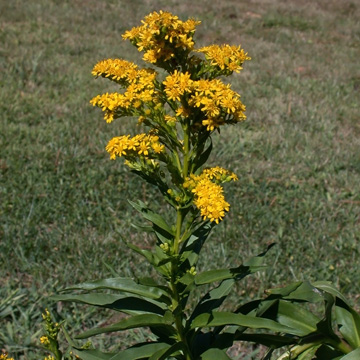

Solidago sempervirens - (image 1 of 5)
Taxonomy
Family: Asteraceae
Habitat
Saline places along the coast, inland salt marshes, and further inland along highways that are salted in the winter.
Associates
Distribution
Along the coast from the Gulf of St. Lawrence to central America and northern West Indies; formerly in salt marshes in central NY; now introduced and spreading inland in southwestern Ontario, NY, eastern Michigan and adjacent OH, and in IL and IN at the southern end of Lake Michigan.
Morphology
Herbaceous perennial from a short and compact caudex; stems 40-100 cm, glabrous or scabrous-puberulent in the inflorescence; leaves more or less basally disposed, entire, somewhat succulent, the largest ones oblanceolate, the cauline ones rather numerous; inflorescence dense, paniculiform, sometimes leafy in the lower portion, at least the lower branches recurved-secund; involucres 3-7 mm; involucral bracts acute or acuminate; rays 3-5 mm; achenes hairy.
Notes
Flowers September to October
Wetland indicator: FACW
Easily distinguished from other lowland Solidago spp. by its waxy and somewhat succulent leaves. Although associated with saline habitats this species can be grown in non-saline soil and in rich soil it can get quite tall. It is not as attractive as many other goldenrods but can be useful in areas that receive salt in the winter. Can hybridize with S. rugosa if the two are grown together.
References
Gleason, Henry A. and A. Cronquist. 1991. Manual of Vascular Plants of
Northeastern United States
and Adjacent Canada. Second Ed.
The New York Botanical Garden. Bronx, NY
|
Michael Hough © 2018 |